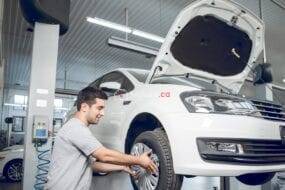Connected Car Ecosystems From Smart Cities to Smart Vehicles In the ever-evolving landscape of technology, one of the most transformative and promising developments is the rise of connected car ecosystems. The convergence of automotive engineering, artificial intelligence, and the Internet of Things (IoT) has given birth to a new era where vehicles are not just modes of transportation but integral components of a larger interconnected network. This paradigm shift is not only reshaping the automotive industry but is also fostering the creation of smart cities, where vehicles seamlessly communicate with each other and their surroundings. This article explores the multifaceted dimensions of connected car ecosystems, from their technological underpinnings to their impact on urban landscapes.
The Foundation: Technological Underpinnings of Connected Car Ecosystems
Connected car ecosystems rely on a sophisticated blend of technologies that empower vehicles to communicate with each other and with the infrastructure around them. At the heart of this evolution is the integration of IoT devices into vehicles, enabling them to gather and exchange data in real-time. These devices encompass a range of sensors, from cameras and radar to lidar, which allow cars to perceive their environment and make intelligent decisions. The connectivity of vehicles is facilitated by advanced telematics systems, which serve as the nerve center of the connected car ecosystem. These systems leverage high-speed internet connections to enable constant communication between vehicles and external networks, such as smart traffic lights, road sensors, and other connected vehicles. Moreover, the integration of Artificial Intelligence (AI) algorithms plays a pivotal role in processing the vast amount of data generated by these systems, enabling vehicles to adapt to changing conditions and make split-second decisions.
II. Enabling Smarter Cities: The Impact on Urban Infrastructure
The implications of connected car ecosystems extend far beyond the confines of individual vehicles. As more cars become connected, cities are transforming into smart urban hubs where traffic management, safety, and efficiency are optimized through real-time data exchange. Intelligent traffic management systems use data from connected vehicles to dynamically adjust traffic signals, manage congestion, and optimize traffic flow. Emergency services also benefit significantly from connected car ecosystems. In the event of an accident, vehicles can automatically transmit data about the severity and location of the incident to emergency responders, enabling faster and more targeted assistance. This not only improves response times but can also save lives. Furthermore, the integration of connected vehicles into smart city grids contributes to energy efficiency. Vehicles can receive real-time information about traffic conditions, allowing them to optimize routes and reduce fuel consumption. This not only lowers carbon emissions but also contributes to a more sustainable urban environment.
Enhanced Safety: Vehicle-to-Everything (V2X) Communication
Connected car ecosystems are ushering in a new era of enhanced safety through Vehicle-to-Everything (V2X) communication. This technology allows vehicles to communicate not only with each other (Vehicle-to-Vehicle or V2V) but also with infrastructure (Vehicle-to-Infrastructure or V2I) and pedestrians (Vehicle-to-Pedestrian or V2P). The seamless exchange of information reduces the risk of accidents by providing drivers with real-time insights into their surroundings. For example, if a vehicle ahead suddenly applies its brakes, it can send a signal to the vehicles behind, triggering automatic braking systems and preventing a potential collision. Similarly, V2I communication can inform drivers about traffic conditions, road closures, or upcoming hazards, enhancing overall road safety.
Overcoming Challenges: Security and Privacy Concerns
While the promise of connected car ecosystems is immense, it is not without its challenges. The foremost concern is the security and privacy of the vast amounts of data exchanged between vehicles and infrastructure. As vehicles become modern connected, they become potential targets for cyberattacks. Manufacturers and policymakers must implement robust cybersecurity measures to safeguard against unauthorized access and protect sensitive data. Moreover, the collection and utilization of personal data raise privacy concerns. Striking a balance between the benefits of data-driven services and protecting individuals’ privacy will be crucial for the widespread acceptance of connected car ecosystems.
The Road Ahead: Future Developments and Implications
The evolution of connected car ecosystems is far from reaching its zenith. As technology continues to advance, we can anticipate even more sophisticated features and capabilities. The advent of 5G connectivity will further enhance data exchange speeds, enabling near-instantaneous communication between vehicles and infrastructure. Autonomous driving, a natural progression in the connected car evolution, holds the potential to revolutionize transportation. Vehicles with the ability to navigate without human intervention can further optimize traffic flow, reduce accidents, and provide new levels of accessibility for individuals who are unable to drive.
Conclusion
In conclusion, Connected Car Ecosystems are not merely a technological novelty but a transformative force that is reshaping both the automotive industry and urban landscapes. The synergy between smart cities and smart vehicles is creating a future where transportation is not just about getting from point A to point B but about doing so efficiently, safely, and sustainably. As we navigate this exciting terrain, addressing challenges and ensuring the ethical use of technology will be paramount in harnessing the full potential of connected car ecosystems for the benefit of society.





